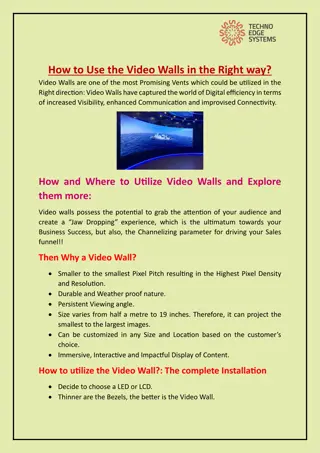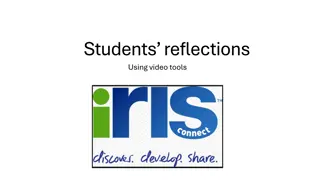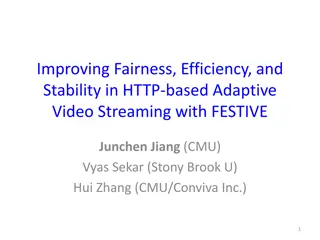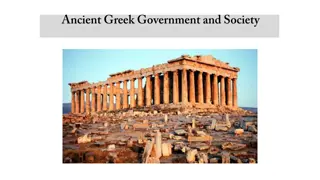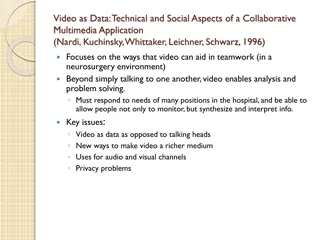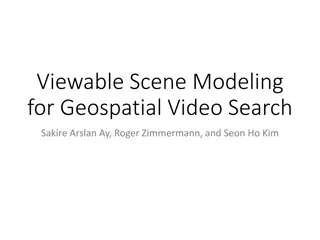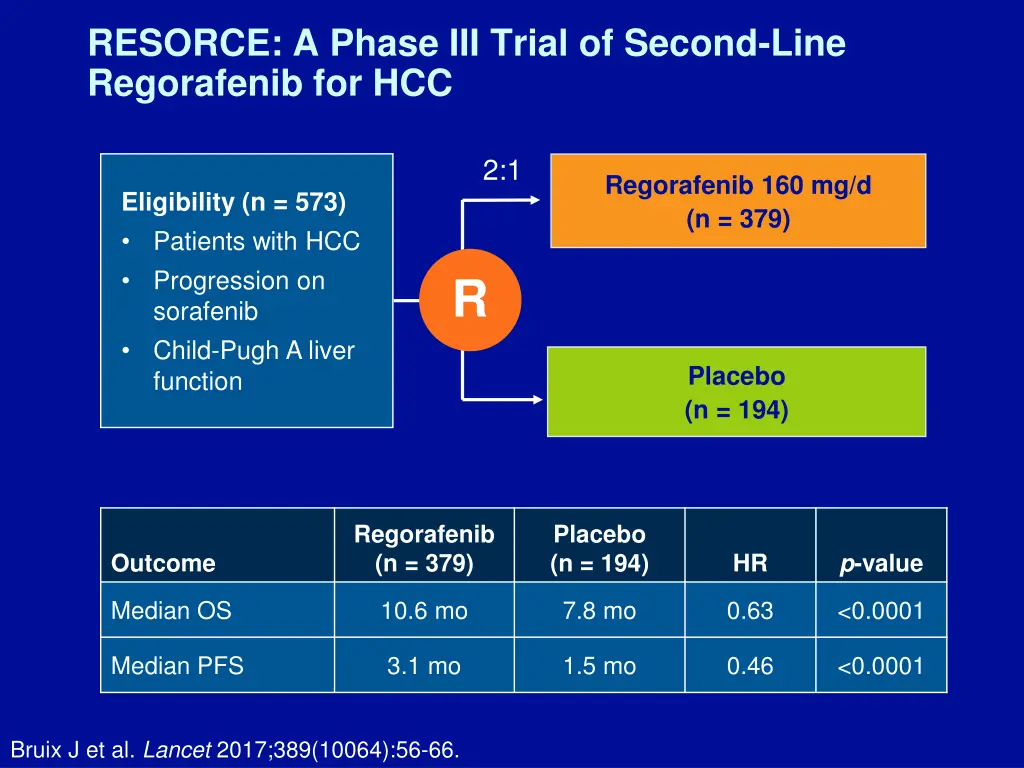
Phase III Trials of Regorafenib and Sorafenib in HCC: Efficacy Comparison
This study compares the efficacy of regorafenib and sorafenib as second-line treatments for patients with hepatocellular carcinoma (HCC) who progressed on sorafenib. Results show that regorafenib demonstrated superior overall survival and progression-free survival compared to sorafenib. Additionally, a significant proportion of patients in the regorafenib group received the full protocol dose with minimal reductions, but drug-related adverse events led to interruptions or dose reductions in some cases. The findings highlight the potential of regorafenib in treating advanced HCC.
Download Presentation

Please find below an Image/Link to download the presentation.
The content on the website is provided AS IS for your information and personal use only. It may not be sold, licensed, or shared on other websites without obtaining consent from the author. If you encounter any issues during the download, it is possible that the publisher has removed the file from their server.
You are allowed to download the files provided on this website for personal or commercial use, subject to the condition that they are used lawfully. All files are the property of their respective owners.
The content on the website is provided AS IS for your information and personal use only. It may not be sold, licensed, or shared on other websites without obtaining consent from the author.
E N D
Presentation Transcript
RESORCE: A Phase III Trial of Second-Line Regorafenib for HCC 2:1 Regorafenib 160 mg/d (n = 379) Eligibility (n = 573) Patients with HCC Progression on sorafenib Child-Pugh A liver function R Placebo (n = 194) Regorafenib (n = 379) Placebo (n = 194) p-value Outcome HR Median OS 10.6 mo 7.8 mo 0.63 <0.0001 Median PFS 3.1 mo 1.5 mo 0.46 <0.0001 Bruix J et al. Lancet 2017;389(10064):56-66.
Phase III Trials of Sorafenib in HCC Sorafenib (n = 299) Placebo (n = 303) p-value SHARP trial1 HR Median OS 10.7 mo 7.9 mo 0.69 <0.001 Sorafenib (n = 150) Placebo (n = 76) p-value Asia-Pacific trial2 HR Median OS 6.5 mo 4.2 mo 0.68 0.014 1 Llovet JM et al. N Engl J Med 2008;359(4):378-90; 2 Cheng AL et al. Lancet Oncol 2009;10(1):25-34.
RESORCE: A Phase III Trial of Second-Line Regorafenib for HCC 2:1 Regorafenib 160 mg/d (n = 379) Eligibility (n = 573) Patients with HCC Progression on sorafenib Child-Pugh A liver function R Placebo (n = 194) Regorafenib (n = 379) Placebo (n = 194) p-value Outcome HR Median OS 10.6 mo 7.8 mo 0.63 <0.0001 Almost half of the regorafenib group (184 [49%] of 374) received the full protocol dose (160 mg/day) with no reductions. Bruix J et al. Lancet 2017;389(10064):56-66.
Study 304 (REFLECT): A Phase III Trial of First- Line Lenvatinib or Sorafenib for HCC 1:1 Lenvatinib Eligibility (n = 954) Patients with unresectable HCC BCLC Stage B or C Child-Pugh A liver function ECOG PS 0-1 12 mg (or 8 mg) QD (oral) (n = 478) R Sorafenib 400 mg BID (oral) (n = 476) Lenvatinib (n = 478) 13.6 mo 8.9 mo 24% Sorafenib (n = 476) 12.3 mo 3.7 mo 9% p-value Outcome Median OS Median TTP ORR HR 0.92 0.63 <0.00001 <0.00001 Subsequent to this interview, these data were presented at ASCO 2017. Cheng AL et al. Proc ASCO 2017;Abstract 4001.
RESORCE: A Phase III Trial of Second-Line Regorafenib for HCC 2:1 Regorafenib 160 mg/d (n = 379) Eligibility (n = 573) Patients with HCC Progression on sorafenib Child-Pugh A liver function R Placebo (n = 194) Almost half of the regorafenib group (184 [49%] of 374) received the full protocol dose (160 mg/day) with no reductions. Drug-related adverse events led to interruptions or dose reductions in 202 (54%) patients in the regorafenib group. Bruix J et al. Lancet 2017;389(10064):56-66.
RESORCE Phase III Trial: Select Adverse Events Regorafenib (n = 374) Placebo (n = 193) Event All Grade 3/4 All Grade 3/4 Hand-foot skin reaction 53% 13% 8% 1% Diarrhea 41% 3% 15% 0% Fatigue 40% 9% 32% 5% Hypertension 31% 15% 6% 5% Increased blood bilirubin 29% 10% 18% 11% Increased AST 25% 11% 20% 11% Ascites 16% 4% 16% 6% Increased ALT 15% 3% 11% 3% Bruix J et al. Lancet 2017;389(10064):56-66.
CheckMate 040: Phase I/II Trial Design Patients with advanced HCC Dose escalation (n = 48) 3 + 3 design Dose expansion (n = 214) 3 mg/kg Sorafenib untreated or intolerant (n = 56) n = 6 n = 9 n = 10 n = 10 n = 13 Without viral hepatitis 0.1 mg/kg (n = 1) 0.3 mg/kg (n = 3) 1.0 mg/kg (n = 3) 3.0 mg/kg (n = 3) 10 mg/kg (n = 13) Sorafenib progressor (n = 57) 0.3 mg/kg (n = 3) 1.0 mg/kg (n = 4) 3.0 mg/kg (n = 3) HCV infected HCV infected (n = 50) HBV infected 0.1 mg/kg (n = 5) 0.3 mg/kg (n = 3) 1.0 mg/kg (n = 3) 3.0 mg/kg (n = 4) HBV infected (n = 51) El-Khoueiry AB et al. Lancet 2017;389(10088):2492-502.
CheckMate 040: Response and Safety During dose-escalation phase (n = 48): Nivolumab showed a manageable safety profile, including acceptable tolerability. 46 (96%) discontinued treatment Incidence of treatment-related adverse events (AEs) did not seem to be associated with dose; no maximum tolerated dose was reached. 12 (25%) had Grade 3/4 treatment-related AEs. 30 (63%) died (not determined to be related to nivolumab). Nivolumab 3 mg/kg was chosen for dose expansion. El-Khoueiry AB et al. Lancet 2017;389(10088):2492-502.
CheckMate 040: Phase I/II Trial Design Dose escalation (n = 48) 3 + 3 design Dose expansion (n = 214) 3 mg/kg Sorafenib untreated or intolerant (n = 56) n = 6 n = 9 n = 10 n = 10 n = 13 Without viral hepatitis 0.1 mg/kg (n = 1) 0.3 mg/kg (n = 3) 1.0 mg/kg (n = 3) 3.0 mg/kg (n = 3) 10 mg/kg (n = 13) Sorafenib progressor (n = 57) 0.3 mg/kg (n = 3) 1.0 mg/kg (n = 4) 3.0 mg/kg (n = 3) HCV infected HCV infected (n = 50) HBV infected 0.1 mg/kg (n = 5) 0.3 mg/kg (n = 3) 1.0 mg/kg (n = 3) 3.0 mg/kg (n = 4) HBV infected (n = 51) With nivolumab at 3 mg/kg: ORR (dose-expansion phase) = 42/214 (20%) El-Khoueiry AB et al. Lancet 2017;389(10088):2492-502.
CheckMate 040: Survival Results Dose escalation (n = 48)* Dose expansion (n = 214) Outcomes Median OS 15 mo NR 6-month OS 66% 83% 9-month OS 66% 74% Median PFS 3.4 mo 4.0 mo 6-month PFS Not reported 37% 9-month PFS Not reported 28% * 37/48 (77%) had previously received sorafenib 145/214 (68%) of patients had previously received sorafenib NR = not reached Median OS uninfected, prior sorafenib in dose-expansion phase (n = 57) = 13.2 mo El-Khoueiry AB et al. Lancet 2017;389(10088):2492-502.
CheckMate 040: Treatment Outcomes Dose escalation (n = 48) Dose expansion (n = 214) Nivolumab ORR 7 (15%) 42 (20%) Median DoR 17 mo 9.9 mo DCR 28 (58%) 138 (64%) 9-month OS 66% 74% El-Khoueiry AB et al. Lancet 2017;389(10088):2492-502.
Select Ongoing Trials of Immune Checkpoint Inhibitors for Patients with Advanced HCC Trial name/identifier CheckMate 459 (NCT02576509) N Phase Setting Treatment arms Nivolumab Sorafenib Nivo at different doses (C1-3) Nivo at a specific dose (C1-3) 1L Nivo vs sorafenib (C4) Nivo vs ipilimumab (C4) Nivo (C5) 726 III First line 2 parts*/5 cohorts (C1- 5) 1) Uninfected 2) HCV infected 3) HBV infected 4) Advanced HCC 5) Child-Pugh B CheckMate 040 (NCT01658878) 620 I/II 1) Advanced BCLC Stage B/C 2) Intra/extrahepatic cholangiocarcinoma Tremelimumab + durvalumab +/- (TACE or RFA or cryoablation) (C1) 16-C-0135 (NCT02821754) 90 I/II *The 2 parts are dose escalation and dose expansion. Clinicaltrials.gov (Accessed July 2017).
Phase II Trial of Tremelimumab Monotherapy in HCC with Chronic Hepatitis C Outcomes n = 17 ORR 17.6% DCR 76.4% Time to progression 6.48 mo Median OS 8.2 mo Sangro B et al. J Hepatol 2013;59(1):81-8.
Ongoing CheckMate 040 Trial Trial name/identifier N Phase Setting Treatment arms 2 parts*/5 cohorts (C1-5) 1) Uninfected 2) HCV infected 3) HBV infected 4) Advanced HCC 5) Child-Pugh B Nivo at different doses (C1-3) Nivo at a specific dose (C1-3) 1L Nivo vs sorafenib (C4) Nivo + ipilimumab (C4) Nivo (C5) CheckMate 040 (NCT01658878) 620 I/II *The 2 parts are dose escalation and dose expansion. Clinicaltrials.gov (Accessed July 2017).
CheckMate 040: Select Adverse Events Nivolumab 3 mg/kg (n = 10) All patients (n = 48) Dose-escalation cohort All grades Grade 3/4 All grades Grade 3/4 Increased AST 1 (10%) 1 (10%) 10 (21%) 5 (10%) Increased ALT 2 (20%) 1 (10%) 7 (15%) 3 (6%) Increased lipase 2 (20%) 1 (10%) 10 (21%) 6 (13%) Increased amylase 2 (20%) 1 (10%) 9 (19%) 2 (4%) One patient without viral hepatitis who received nivolumab 3 mg/kg discontinued due to treatment-related ALT and AST increases without concomitant changes in liver function. El-Khoueiry AB et al. Lancet 2017;389(10088):2492-502.
Case Discussion A 74-year-old man presents with chronic hepatitis B with no evidence of portal hypertension or cirrhosis. Patient has a single 6.5-cm lesion and is diagnosed with moderately differentiated HCC with microscopic vascular invasion Patient underwent surgical liver resection The margins were negative Patient is placed on surveillance and is alive 4 years later with no evidence of recurrence
Case Discussion A 71-year-old man with hepatitis B presents with abdominal pain and weight loss He has elevated liver enzymes with an alpha-fetoprotein level of 1,000 Imaging revealed a heterogenously enhancing infiltrating mass of 6 cm with extension of the tumor. He has tumor thrombosis into the right and left portal veins.
Case Discussion A 71-year-old man with hepatitis B presents with abdominal pain and weight loss He has elevated liver enzymes with an alpha-fetoprotein (AFP) level of 1,000 ng/mL Imaging revealed a heterogenously enhancing infiltrating mass of 6 cm with extension of the tumor. He has tumor thrombosis into the right and left portal veins. A biopsy revealed poorly differentiated HCC and Child- Pugh A cirrhosis. Patient is diagnosed with BCLC Stage C HCC. Received first-line sorafenib about 14 months on a trial upon progression nivolumab for
Case Discussion A 68-year-old woman without viral hepatitis B, but with a metabolic syndrome, diabetes and steatohepatitis NASH presents with upper-quadrant pain and weight loss Patient is diagnosed with NASH-related HCC with Child-Pugh A cirrhosis Ultrasound revealed 2 liver masses, 4 and 6.5 cm Received TACE with doxorubicin beads with residual disease response, but
Case Discussion A 68-year-old woman without viral hepatitis B, but with a metabolic syndrome, diabetes and steatohepatitis NASH presents with upper-quadrant pain and weight loss Patient is diagnosed with NASH-related HCC with Child- Pugh A cirrhosis Ultrasound revealed 2 liver masses, 4 and 6.5 cm Received TACE with doxorubicin beads response, but with residual disease RFA therapy active disease adjacent to treated large mass with invasion into the main portal vein observation for 14 months with no developed new liver lesion sorafenib
Case Discussion A 69-year-old man with a compensated HCV-cirrhosis 2012: Patient has a single HCC (6 cm), no macrovascular invasion (MVI) or extrahepatic spread (EHS) Child-Pugh A, ECOG PS 0, bilirubin level of 1 mg/dL and no portal hypertension Segmental resection: R0, no satellites, microvascular invasion
Liver Transplantation for Small HCC in Patients with Cirrhosis Pts who met the Milan criteria (n = 35) Patients whose tumors exceeded the limits (n = 13) All pts (n = 48) Outcomes 4-year OS 75% 85% 50% 4-year RFS 83% 92% 59% Overall mortality rate (n = 48) = 17% In this group of 48 patients with early-stage tumors, tumor node-metastasis status, the number of tumors, the serum AFP concentration, treatment received before transplantation and 10 other variables were not significantly correlated with survival. Conclusions: Liver transplantation is an effective treatment for small, unresectable HCC in patients with cirrhosis. Mazzaferro V et al. N Engl J Med 1996;334(11):693-9.
Case Discussion A 69-year-old man with a compensated HCV-cirrhosis 2012: Patient has a single HCC (6 cm), no macrovascular invasion (MVI) or extrahepatic spread (EHS) Child-Pugh A, ECOG PS 0, bilirubin level of 1 mg/dL and no portal hypertension Segmental resection: R0, no satellites, microvascular invasion
Case Discussion A 69-year-old man with a compensated HCV-cirrhosis 2012: Patient has a single HCC (6 cm), no macrovascular invasion (MVI) or extrahepatic spread (EHS) Child-Pugh A, ECOG PS 0, bilirubin level of 1 mg/dL and no portal hypertension Segmental resection: R0, no satellites, microvascular invasion 2014: Multinodular HCC recurrence: 3 nodules (max: 4 cm). Patient has Child-Pugh A, ECOG 0, no MVI-EHS, AFP: 100 ng/mL Chemoembolization (TACE x 3): partial response
Case Discussion A 69-year-old man with a compensated HCV-cirrhosis 2012: Patient has a single HCC (6 cm), no macrovascular invasion (MVI) or extrahepatic spread (EHS) Child-Pugh A, ECOG PS 0, bilirubin level of 1 mg/dL and no portal hypertension Segmental resection: R0, no satellites, microvascular invasion 2014: Multinodular HCC recurrence: 3 nodules (max: 4 cm). Patient has Child-Pugh A, ECOG 0, no MVI-EHS, AFP: 100 ng/mL Chemoembolization (TACE x 3): partial response 2016: Progression in main HCC nodule: 5 cm, satellites and branch portal vein thrombosis; Child-Pugh A, ECOG PS 1, bilirubin 1.5 mg/dL, AFP: 600 ng/mL.
Case Discussion A 69-year-old man with a compensated HCV-cirrhosis 2012: Patient has a single HCC (6 cm), no macrovascular invasion (MVI) or extrahepatic spread (EHS) Child-Pugh A, ECOG PS 0, bilirubin level of 1 mg/dL and no portal hypertension Segmental resection: R0, no satellites, microvascular invasion 2014: Multinodular HCC recurrence: 3 nodules (max: 4 cm). Patient has Child-Pugh A, ECOG 0, no MVI-EHS, AFP: 100 ng/mL Chemoembolization (TACE x 3): partial response 2016: Progression in main HCC nodule: 5 cm, satellites and branch portal vein thrombosis; Child-Pugh A, ECOG PS 1, bilirubin 1.5 mg/dL, AFP: 600 ng/mL. Treatment strategy? (a) TACE; (b) Sorafenib; (c) TARE (Y-90); (d) Radiation therapy
BCLC Staging and Treatment Schedule Unresectable HCC Llovet JM et al. Nat Rev Dis Primers 2016;2:16018.
Intermediate Advanced HCC: Redefining Unresectable HCC Natural History (BCLC B and C) Survival BCLC C stage (n = 376) Survival BCLC B stage (n = 370) Stage 0 Stage 1 Median survival: Placebo 15.8m Seocalcitol 15.1m Median survival: Placebo 5.7m Seocalcitol 5.6m Survival Survival Time since treatment start (months) Time since treatment start (months) RCT seocalcitol vs placebo (n = 746) Courtesy of Josep M Llovet, MD, PhD
BCLC Staging and Treatment Schedule Llovet JM et al. Nat Rev Dis Primers 2016;2:16018.
Evidence and Recommendations for HCC Therapies Sorafenib Chemoembolization RF (<5 cm), RF/PEI (<2 cm) Resection 1 Adjuvant therapy after reseaction Levels of evidence LDLT OLT-Milan Internal radiation 2 OLT-extended Neoadjuvant therapy in waiting list Downstaging 3 External/palliative radiation therapy C B A C B A 2 (weak) 1 (strong) Grade of recommendation EASL-EORTC clinical practice guidelines. J Hepatol 2012;56(4):908-43.
Systemic Therapies: Sorafenib Clinical Practice Summary Systemic therapies Sorafenib is the standard systemic therapy for HCC. It is indicated for patients with well- preserved liver function (Child-Pugh A class) and with advanced tumors (BCLC C) or those tumors progressing upon locoregional therapies (evidence 1iA; recommendation 1A) There are no clinical or molecular biomarkers available to identify the best responders to sorafenib (evidence 1A; recommendation 2A) SHARP trial results Median OS (N = 602): Sorafenib = 10.7 mo Placebo = 7.9 mo HR = 0.69 p < 0.001 Systemic chemotherapy, tamoxifen, immunotherapy, anti-androgen and herbal drugs are not recommended for the clinical management of HCC (evidence 1-2A; recommendation 1A/B) EASL-EORTC clinical practice guidelines. J Hepatol 2012;56(4):908-43; Llovet JM et al. N Engl J Med 2008;359(4):378-90.
SHARP: Subgroup Analysis Number of patients Sor OS (mo) Subgroup domain Group evaluated PI Sor PI HR MVI/EHS both absent 90 91 14.5 10.2 0.52 MVI/EHS both present 209 212 8.9 6.7 0.77 MVI absent 190 179 14.1 10.2 0.74 Tumor burden MVI present 108 123 8.1 4.9 0.68 EHS absent 140 153 14.1 7.9 0.55 EHS present 159 150 8.9 8.3 0.85 ECOG PS 0 161 164 13.3 8.8 0.68 Performance status ECOG PS 1-2 138 139 8.9 5.6 0.71 BCLC B 54 51 14.5 11.4 0.72 Tumor stage BCLC C 245 252 9.7 7.0 0.70 Prior curative treatment 81 77 11.9 8.8 0.79 Prior therapy Prior TACE 86 90 11.9 9.9 0.75 MVI = microvascular invasion Bruix J et al. J Hepatol 2012;57(4):821-9.
Alternative Therapies for MVI in HCC: Surgical Resection Number of patients Wu 112 Survival Median (mo) NA 5 year (%) 27 Series Predictors of outcome NA Tumor size 10 cm, satellites, margins NA Adjuvant CT Adjuvant CT, tumor size 10 cm Fibrosis NA Extent of invasion NA Ascites, INR, tumor size 5 cm Adjuvant treatment, grade, tumor size NA AFP <2,000, serosal invasion NA Total bilirubin, alkaline phosphatase, extent of invasion NA Extent of invasion Retrospective Study by Roayaie et al. N = 165 Median OS = 13.1 mo 5-year OS = 14% Ohkubo 47 NA 24 Poon Fan Fan Pawlik Le Treut Chen Zhou Ikai 20 83 108 102 26 438 381 78 6 NA 14 15 10 13 12 12 22 13 14 11 9 16 NA 9 Liang 86 10 9 Shimada Ban Inoue 22 45 49 7 0 20 19 22 40 Kondo 48 13 NA Ruzzenente Shi 17 406 10 6 20 13 Retrospective studies, underpowered; selection bias; lack of ITT analysis Hypothesis generating Roayaie S et al. Ann Surg Oncol 2013;20(12):3754-60.
Alternative Therapies for MVI in HCC: Loco- regional Therapies (TACE and Radiation Therapy) Author Treatment (n) Survival Xue, BMC Gastro 2013 TACE (923) Meta-analysis TACE (95) TACE-DEB (38) TACE+S (46) TACE (45) Y-90 Child-Pugh A (45) Y-90 Child-Pugh B (28) Sorafenib (40) Radiation therapy (57) 5 mo 3.3 mo 13 mo 6 mo 13.8 mo 6.5 mo 4.3 mo 5.9 mo Gorodetski, Eur Rad 2016 Zhu K, Radiology 2014 Memon K, J Hep 2013 Nakazawa, BMCGastro 2014 Retrospective studies, underpowered Selection bias; lack of ITT analysis Hypothesis generating
Radioembolization 90Y for Portal Vein Invasion in HCC Prospective/Retrospective Studies Reporting on long-term outcome after 90Y radioembolization Intermediate stage Branch PVT Main PVT Branch or main PVT Child- Pugh A Reference Hilgard et al. (N = 108) N OS N OS N OS N OS A/B 51 16.4 33 10 A 48 17.3 19 16.6 16 7.7 35 10.4 Salem et al. (N = 291) B 35 13.5 27 6.5 30 4.5 57 5.6 A 82 18.4 44 10.7 32 9.7 76 10.2 Sangro et al. (N = 325) B A B 5 3.6 18 15 2 23 6 17 8 5 1 9 5 Mazzaferro et al. (N = 51) Hypothesis generating Select ongoing large-scale randomized trials with 90Y radioembolization in HCC Salem R et al. Hepatol 2013;58(6):2188-97.
Select Large-Scale Randomized Trials with 90Y Radioembolization in HCC Trial name/identifier PREMIERE (NCT00956930) N Phase Setting Treatment arms Radioembolization TACE RFA Sorafenib or placebo Sorafenib +/- SIRT Sorafenib SIR-Spheres Sorafenib SIR-Spheres Sorafenib Sorafenib + TheraSphere Untreatable with RFA or surgery 45 II SORAMIC (NCT01126645) 529 II Unresectable SIRveNIB (NCT01135056) SARAH (NCT01482442) Locally advanced 360 III 496 III Advanced STOP-HCC (NCT01556490) 390 III Unresectable Advanced with portal vein thrombosis YES-P (NCT01887717) Sorafenib TheraSphere 328 III Clinicaltrials.gov (Accessed July 2017).
Case Discussion A 69-year-old man with a compensated HCV-cirrhosis 2012: Patient has a single HCC (6 cm), no macrovascular invasion (MVI) or extrahepatic spread (EHS) Child-Pugh A, ECOG PS 0, bilirubin level of 1 mg/dL and no portal hypertension Segmental resection: R0, no satellites, microvascular invasion 2014: Multinodular HCC recurrence: 3 nodules (max: 4 cm). Patient has Child-Pugh A, ECOG 0, no MVI- EHS, AFP: 100 ng/mL Chemoembolization (TACE x 3): partial response 2016: Progression in main HCC nodule: 5 cm, satellites and branch portal vein thrombosis; Child-Pugh A, ECOG PS 1, bilirubin 1.5 mg/dL, AFP: 600 ng/mL. Patient received sorafenib disease progression
RESORCE: A Phase III Trial of Second-Line Regorafenib for HCC 2:1 Regorafenib 160 mg/d (n = 379) Eligibility (n = 573) Patients with HCC Progression on sorafenib Child-Pugh A liver function R Placebo (n = 194) Regorafenib (n = 379) Placebo (n = 194) p-value Outcome HR Median OS 10.6 mo 7.8 mo 0.63 <0.0001 Bruix J et al. Lancet 2017;389(10064):56-66.
Molecular Therapies Tested in HCC (Phase III) Targeted population Phase III comparision 1. Sorafenib vs placebo (STORM)* 2. Retinoids vs placebo* 1. RF vs RF-Dox* 2. TACE +/- sorafenib* 3. TACE +/- brivanib* 1. Sorafenib +/- erlotinib* 2. Sorafenib vs brivanib* 3. Sorafenib vs sunitinib* 4. Sorafenib vs linifanib* 5. Sorafenib +/- doxorubicin* 6. Sorafenib +/- Y90 7. Sorafenib vs lenvatinib 8. Sorafenib vs nivolumab 1. Brivanib vs placebo* 2. Everolimus vs placebo* 3. Ramucirumab vs placebo* 4. Regorafenib vs placebo 5. Tivantinib vs placebo 6. Cabozantinib vs placebo 7. Pembrolizumab vs placebo Adjuvant Prevent recurrences Intermediate HCC Improve TACE First line Advanced HCC Second line *RCT halted or with unconclusive or negative results Courtesy of Josep M Llovet, MD, PhD
Molecular Therapies Tested in HCC (Phase III) Targeted population Phase III comparision 1. Sorafenib vs placebo (STORM)* 2. Retinoids vs placebo* 1. RF vs RF-Dox* 2. TACE +/- sorafenib* 3. TACE +/- brivanib* 1. Sorafenib +/- erlotinib* 2. Sorafenib vs brivanib* 3. Sorafenib vs sunitinib* 4. Sorafenib vs linifanib* 5. Sorafenib +/- doxorubicin* 6. Sorafenib +/- Y90 7. Sorafenib vs lenvatinib 8. Sorafenib vs nivolumab 1. Brivanib vs placebo* 2. Everolimus vs placebo* 3. Ramucirumab vs placebo* 4. Regorafenib vs placebo 5. Tivantinib vs placebo 6. Cabozantinib vs placebo 7. Pembrolizumab vs placebo Adjuvant Prevent recurrences Intermediate HCC Improve TACE First line Advanced HCC Second line *RCT halted or with unconclusive or negative results Courtesy of Josep M Llovet, MD, PhD
Reasons Why Randomized Trials are Negative in HCC 1) Limited understanding of molecular drivers 2) Lack of translation of knowledge into trial design 3) Two diseases: HCC and Cirrhosis Balance between efficacy and toxicity Sunitinib, linifanib Difficult trial design Noninferiority concept (brivanib, linifanib) Surrogate endpoints of survival? TTP (contradictory data), ORR 4) Moving to Phase III without clear signals Sunitinib, erlotinib 5) Drugs are not powerful enough Brivanib, linifanib, erlotinib, everolimus, ramucirumab, doxorubicin Courtesy of Josep M Llovet, MD, PhD
Phase II Trial of Second-Line Regorafenib Safety (n = 36) Dose Efficacy (n = 36) Event HFSR Diarrhea Fatigue Hypothyroidism Hypertension All 53% 53% 53% 42% 36% Grade 3 14% 6% 17% 0% 3% DCR: 72% PR: 3% SD: 69% Median TTP: 4.3 mo Median OS: 13.8 mo 160 mg PO QD (21 d on/7 d off) Bruix J et al. Eur J Cancer 2013;49(16):3412-9.
RESORCE: A Phase III Trial of Second-Line Regorafenib for HCC 2:1 Regorafenib 160 mg/d (n = 379) Eligibility (n = 573) Patients with HCC Progression on sorafenib Child-Pugh A liver function R Placebo (n = 194) Regorafenib (n = 379) Placebo (n = 194) p-value Outcome HR Median OS 10.6 mo 7.8 mo 0.63 <0.0001 Bruix J et al. Lancet 2017;389(10064):56-66.
RESORCE Phase III Trial: Select Adverse Events Regorafenib (n = 374) Placebo (n = 193) Event All Grade 3/4 All Grade 3/4 Hand-foot skin reaction 53% 13% 8% 1% Diarrhea 41% 3% 15% 0% Fatigue 40% 9% 32% 5% Hypertension 31% 15% 6% 5% Bruix J et al. Lancet 2017;389(10064):56-66.
Case Discussion A 69-year-old man with a compensated HCV-cirrhosis 2012: Patient has a single HCC (6 cm), no macrovascular invasion (MVI) or extrahepatic spread (EHS) Child-Pugh A, ECOG PS 0, bilirubin level of 1 mg/dL and no portal hypertension Segmental resection: R0, no satellites, microvascular invasion 2014: Multinodular HCC recurrence: 3 nodules (max: 4 cm). Patient has Child-Pugh A, ECOG 0, no MVI-EHS, AFP: 100 ng/mL Chemoembolization (TACE x 3): partial response 2016: Progression in main HCC nodule: 5 cm, satellites and branch portal vein thrombosis; Child-Pugh A, ECOG PS 1, bilirubin 1.5 mg/dL, AFP: 600 ng/mL. Patient received sorafenib disease progression
Lenvatinib as First-Line Therapy: Activity PR (%) SD (%) TTP OS Inclusion criteria Exclusion criteria (months) (months) Simultaneous cancers, ascites, effusion, brain metastases, portal vein shunt, use of CYP3A4 Lenvatinib Phase I Advanced HCC, CP-A, B 20 45 3.7 Advanced HCC, CP-A, previous 1 line of systemic treatment Simultaneous cancers, ascites, effusion, brain metastases, portal vein shunt, use of CYP3A4 Lenvatinib Phase II 32.6 45.7 7.49 13.9 Tumor of mixed histology, pregnant or lactating, those requiring systemic anticancer therapy, biologic response modifiers Advanced, biopsy- proven HCC, chemo- na ve, CP-A/B, ECOG PS 0-1 Sorafenib Phase I 2.2 33.6 4.2 9.2 Advanced HCC, second-line therapy, CLIP score 3 or less, ECOG PS 0-2 Brivanib Phase II Active bacterial infection, HIV, significant cardiovascular disease 4.3 41.3 2.7 9.79 Advanced HCC, chemo-na ve, ECOG PS 0-1, CP <B8 Sunitinib Phase II Previous chemotherapy 12 42.1 2.8 5.8 CP = Child-Pugh Courtesy of Josep M Llovet, MD, PhD
Lenvatinib vs Sorafenib: Adverse Events and Ongoing Trial Lenvatinib Phase II; all grades (%) Sorafenib SHARP trial; all grades (%) Adverse event Fatigue 54 22 Hand-foot syndrome 65 21 Anorexia 59 14 Diarrhea 39 Hypertension 76 5 Thrombocytopenia 52 Proteinuria 54 Leukopenia 7.9 Subsequent to this interview, the results of the Phase III REFLECT open-label, noninferiority trial of lenvatinib vs sorafenib were presented at ASCO 2017. Ikeda K et al. Proc ESMO 2012;Abstract 737P; Llovet JM et al. N Engl J Med 2008; 359(4):378-90. Clinicaltrials.gov (Accessed July 2017).
CheckMate 040: A Phase I/II Trial of Nivolumab in Advanced HCC Dose escalation (n = 48) 3 + 3 design Dose expansion (n = 214) 3 mg/kg Sorafenib untreated or intolerant (n = 56) n = 6 n = 9 n = 10 n = 10 n = 13 Without viral hepatitis 0.1 mg/kg (n = 1) 0.3 mg/kg (n = 3) 1.0 mg/kg (n = 3) 3.0 mg/kg (n = 3) 10 mg/kg (n = 13) Sorafenib progressor (n = 57) 0.3 mg/kg (n = 3) 1.0 mg/kg (n = 4) 3.0 mg/kg (n = 3) HCV infected HCV infected (n = 50) HBV infected 0.1 mg/kg (n = 5) 0.3 mg/kg (n = 3) 1.0 mg/kg (n = 3) 3.0 mg/kg (n = 4) HBV infected (n = 51) El-Khoueiry AB et al. Lancet 2017;389(10088):2492-502.
CheckMate 040: A Phase I/II Trial of Nivolumab in Advanced HCC Dose escalation (n = 48) 3 + 3 design Dose expansion (n = 214) 3 mg/kg Sorafenib untreated or intolerant (n = 56) n = 6 n = 9 n = 10 n = 10 n = 13 Without viral hepatitis 0.1 mg/kg (n = 1) 0.3 mg/kg (n = 3) 1.0 mg/kg (n = 3) 3.0 mg/kg (n = 3) 10 mg/kg (n = 13) Sorafenib progressor (n = 57) 0.3 mg/kg (n = 3) 1.0 mg/kg (n = 4) 3.0 mg/kg (n = 3) HCV infected HCV infected (n = 50) HBV infected 0.1 mg/kg (n = 5) 0.3 mg/kg (n = 3) 1.0 mg/kg (n = 3) 3.0 mg/kg (n = 4) HBV infected (n = 51) Cohort Dose-escalation cohort Dose-expansion cohort N 48 214 ORR 7 (15%) 42 (20%) 9-month OS 66% 74% Median OS 15 mo Not reached Median OS uninfected, prior sorafenib in dose-expansion phase (n = 57) = 13.2 mo El-Khoueiry AB et al. Lancet 2017;389(10088):2492-502.
CheckMate 459: An Ongoing Phase III Trial Target accrual (n = 726) Pts with advanced HCC Not eligible for surgical and/or locoregional therapies or Progressive disease after surgical and/or locoregional therapies Child-Pugh A ECOG PS 0-1 No prior liver transplant Nivolumab R Sorafenib Primary endpoints: OS and ORR Clinicaltrials.gov (Accessed July 2017).


